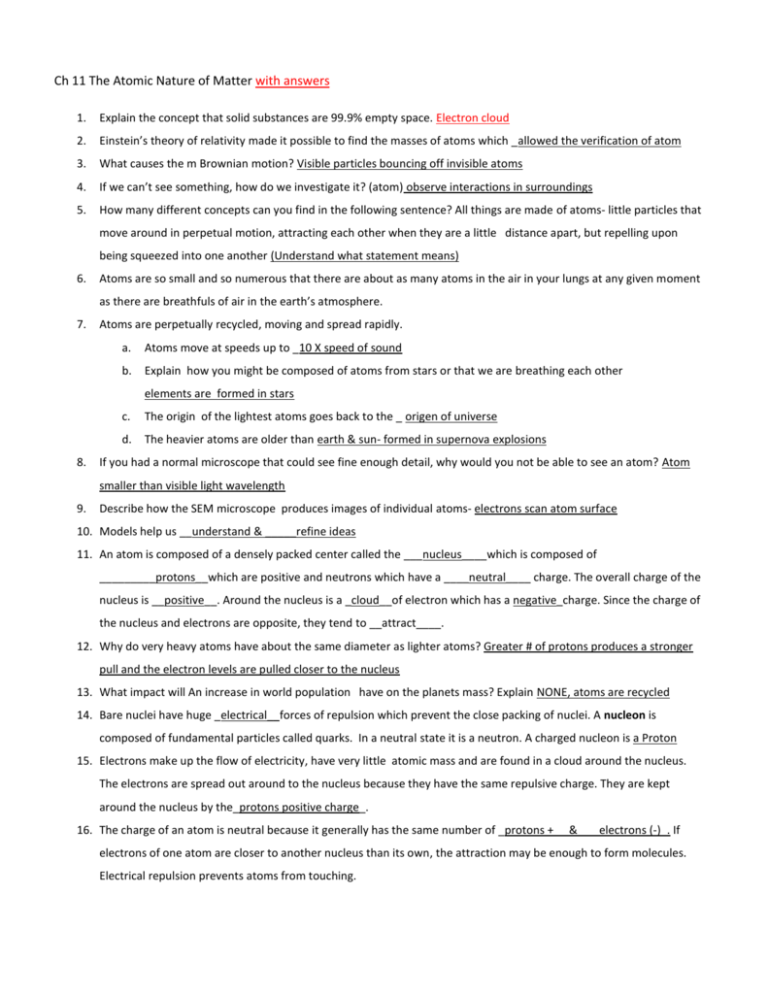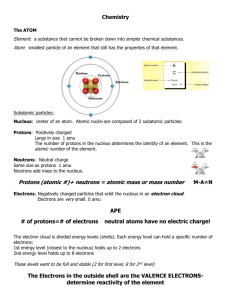Ch 11 The Atomic Nature of Matter with answers Explain the concept
advertisement

Ch 11 The Atomic Nature of Matter with answers 1. Explain the concept that solid substances are 99.9% empty space. Electron cloud 2. Einstein’s theory of relativity made it possible to find the masses of atoms which _allowed the verification of atom 3. What causes the m Brownian motion? Visible particles bouncing off invisible atoms 4. If we can’t see something, how do we investigate it? (atom) observe interactions in surroundings 5. How many different concepts can you find in the following sentence? All things are made of atoms- little particles that move around in perpetual motion, attracting each other when they are a little distance apart, but repelling upon being squeezed into one another (Understand what statement means) 6. Atoms are so small and so numerous that there are about as many atoms in the air in your lungs at any given moment as there are breathfuls of air in the earth’s atmosphere. 7. Atoms are perpetually recycled, moving and spread rapidly. a. Atoms move at speeds up to _10 X speed of sound b. Explain how you might be composed of atoms from stars or that we are breathing each other elements are formed in stars 8. c. The origin of the lightest atoms goes back to the _ origen of universe d. The heavier atoms are older than earth & sun- formed in supernova explosions If you had a normal microscope that could see fine enough detail, why would you not be able to see an atom? Atom smaller than visible light wavelength 9. Describe how the SEM microscope produces images of individual atoms- electrons scan atom surface 10. Models help us __understand & _____refine ideas 11. An atom is composed of a densely packed center called the ___nucleus____which is composed of _________protons__which are positive and neutrons which have a ____neutral____ charge. The overall charge of the nucleus is __positive__. Around the nucleus is a _cloud__of electron which has a negative_charge. Since the charge of the nucleus and electrons are opposite, they tend to __attract____. 12. Why do very heavy atoms have about the same diameter as lighter atoms? Greater # of protons produces a stronger pull and the electron levels are pulled closer to the nucleus 13. What impact will An increase in world population have on the planets mass? Explain NONE, atoms are recycled 14. Bare nuclei have huge _electrical__forces of repulsion which prevent the close packing of nuclei. A nucleon is composed of fundamental particles called quarks. In a neutral state it is a neutron. A charged nucleon is a Proton 15. Electrons make up the flow of electricity, have very little atomic mass and are found in a cloud around the nucleus. The electrons are spread out around to the nucleus because they have the same repulsive charge. They are kept around the nucleus by the_protons positive charge_. 16. The charge of an atom is neutral because it generally has the same number of _protons +__ & ___electrons (-)_. If electrons of one atom are closer to another nucleus than its own, the attraction may be enough to form molecules. Electrical repulsion prevents atoms from touching. 17. An atom is the smallest sample of an _element_. The most abundant element (90% of universe) is _hydrogen____ which is also the lightest element. It combines in fusion to form helium. Heavier atoms are produced inside the stars when they explode as a __supernova_. Nearly all the elements on earth of remnants of stars. 18. There are only about _100_natural elements. Those higher than 92 are synthetic and are produced by atomic accelerators and _nuclear reactors____. 19. 99 % of the elements are composed of only 5 elements _oxygen, hydrogen, nitrogen, carbon, calcium_. 20. The atomic number of an element is based on ___# of protons in nucleus_____. 21. Elements are placed into a chart which places atoms with similar properties into __columns__ and __groups_____. The AMU is the ___atomic mass unit- which is the mass of the protons and neutrons in the nucleus____ 22. Predict the number of shells and electrons for elements on a periodic table, in the A groups. 23. If the number of protons in an element is changed, a _new element_____is formed. 24. If the number of electrons in an element is changed, a _ion____is formed. 25. If the number of neutrons in an element is changed, a ___isotope__is formed. 26. If H has one proton and no neutrons it is called Hydrogen-1. What is it called if you have one proton and one neutron?___H-2__, What is it if there is one proton and 2 neutron -__H-3__ with the # indicating atomic mass. 27. In chemical reactions, atoms rearrange to form different molecules. Compounds are composed of 2 or more elements which combine chemically and they are represented by a _chemical formula__. They cannot be decomposed by simple means. A molecule is formed when atoms are shared in a bond. Energy is needed to separate atoms in molecules or to join them. Ex. Photosynthesis uses sunlight to rearrange atoms of CO2 and H20, which releases this energy when the carbohydrates formed are broken down. 28. Antimatter is produced using large _particle accelerators. While a normal atom has a positive nucleus and negatively charged electrons, in antimatter, the nucleus has a negative charge and positive_electrons called _positrons 29. These particles have the same mass and magnitude of charge but have opposite charges. So, positrons are __positive electrons___, and the antiproton is a _negative proton___ 30. For every particle there is an antiparticle (including antiquarks). It is difficult to distinguish between matter and antimatter using gravitational forces or light. 31. Matter and antimatter mutually annihilate each other with most of the matter converted into ___energy (light)__ with 100 % mass conversion. Ex. Antimatter would be completely transformed to radiant energy as soon as it touched matter, consuming an equal amount of normal matter in the process. If 2 grams of antimatter contacted 10 grams of matter, how much matter would be left? ___8 g matter__. It is possible for other galaxy’s to have antimatter. In the last 100 years, based on the measurement of gravitational forces it has been confirmed that 23 % of the matter in the universe is dark matter. Exotic matter is different from the elements on our periodic table. 32. Observation of the atomic spectra of star light indicates that our observable universe is composed of the elements in the periodic table. However there is more mass out there than we can directly see which is called _dark matter_. 33. Much of the rest of the universe is dark energy which pushes outward on the expanding universe. Both dark matter and dark energy makes up some 90% of the universe. Dark matter and dark energy seem to be different energy but we don’t know what they are. We know enough to realize that the universe is still full of mysteries. 34. We build on the knowledge of previous scientist. Explain the advantages and disadvantages.








